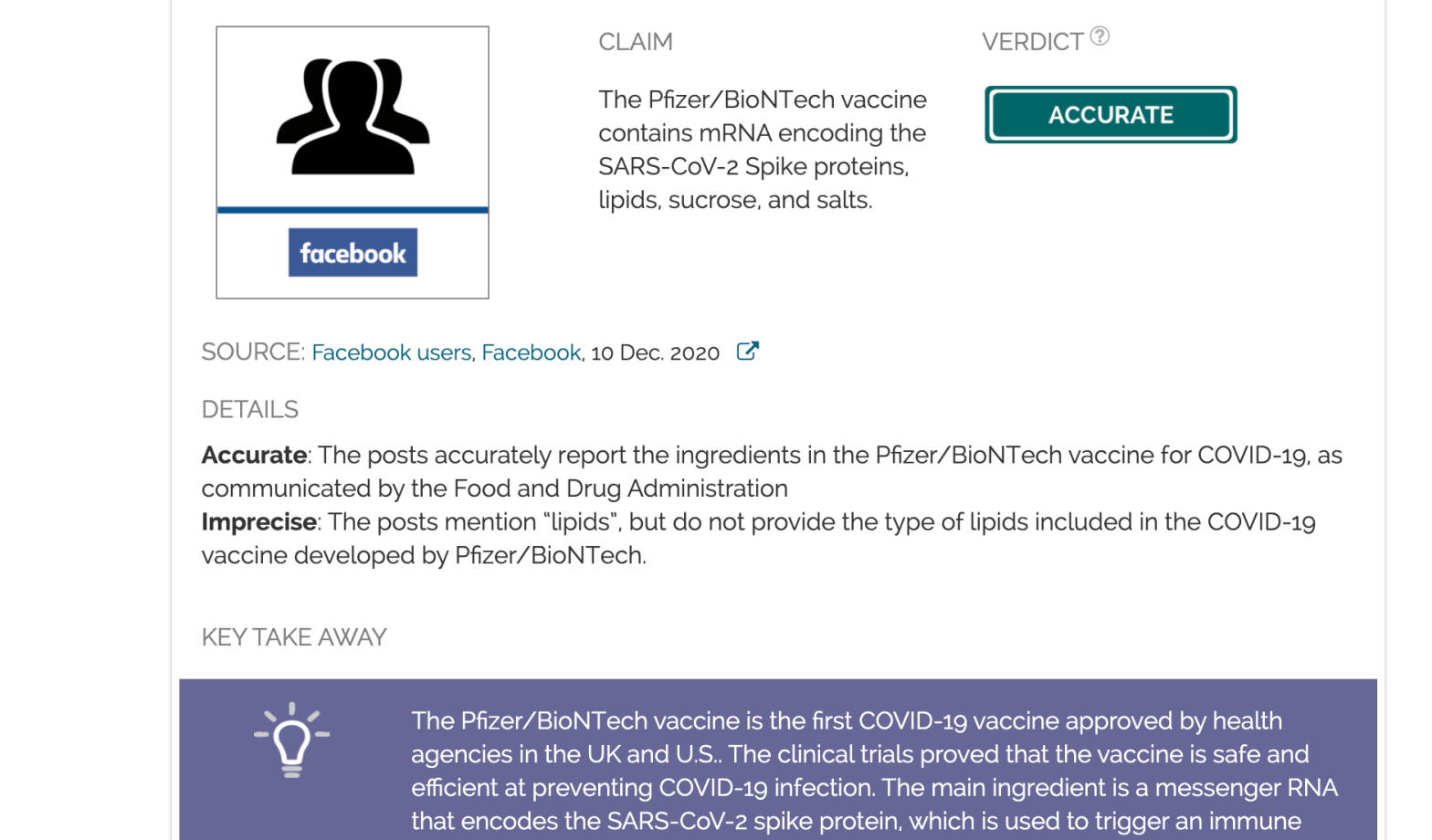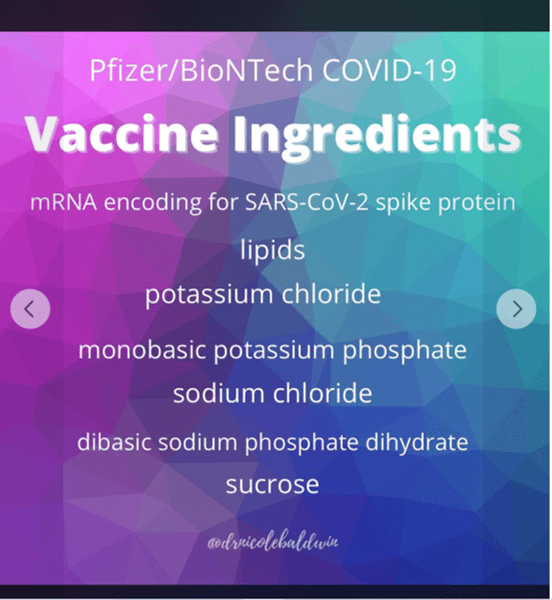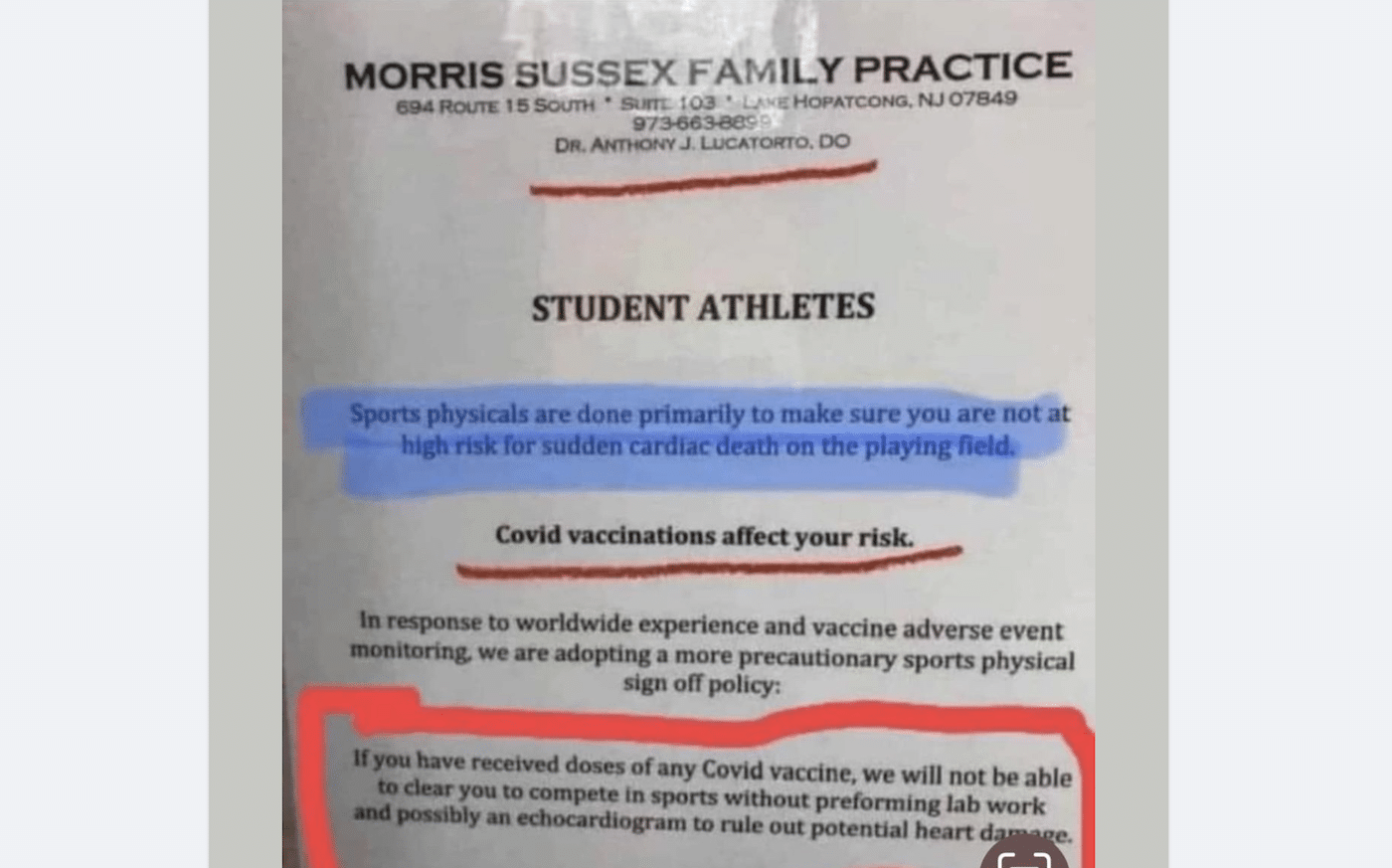- Health
The COVID-19 vaccine from Pfizer/BioNTech is comprised of ingredients standard in many vaccines, including mRNA, lipids, sucrose, and salts
Key takeaway
The Pfizer/BioNTech vaccine is the first COVID-19 vaccine approved by health agencies in the U.K. and the U.S. The clinical trials proved that the vaccine is safe and efficient at preventing COVID-19 infection. The main ingredient is a messenger RNA that encodes the SARS-CoV-2 spike protein, which is used to trigger an immune response. The other ingredients, including the lipids that allow the mRNA to enter human cells, are common in drug formulation.
Reviewed content

Verdict:
Claim:
The Pfizer/BioNTech vaccine contains mRNA encoding the SARS-CoV-2 spike protein, lipids, sucrose, and salts.
Verdict detail
Accurate: The posts accurately report the ingredients in the Pfizer/BioNTech vaccine for COVID-19, as communicated by the U.S. Food and Drug Administration.
Imprecise: The posts mention “lipids,” but do not specify the type of lipids included in the COVID-19 vaccine developed by Pfizer/BioNTech.
Full Claim
The Pfizer/BioNTech vaccine contains mRNA encoding the SARS-CoV-2 spike protein, lipids, sucrose and salts (potassium chloride, monobasic potassium phosphate, sodium chloride, dibasic sodium phosphate dihydrate).
Review
With the initial rollout of the first vaccine against COVID-19 in the U.S., claims regarding the composition of the Pfizer/BioNTech vaccine began circulating on social media. One example can be seen below:

Vaccine composition has been a subject of anti-vaccine misinformation in the past, with recurrent inaccurate claims that vaccines contain toxic ingredients or human fetal cells. Therefore, it is important to release an accurate and exhaustive list of vaccine ingredients before distributing the vaccine to the population.
The first COVID-19 vaccine approved for public use by health agencies in the UK and U.S. is BNT162b2. It was developed using recent messenger RNA (mRNA)-based vaccine technology by the U.S. company Pfizer and the German biotech BioNTech. Some posts claim that it contains “mRNA encoding for SARS-CoV-2 Spike protein,” “lipids,” salts, and sucrose. This list of ingredients is accurate and consistent with the standard composition of drugs. However, the level of detail in the posts could be improved by specifying the composition of the lipidic component.
A briefing document from the U.S. Food and Drug Administration, the public authority responsible for the authorization of drug and vaccines in the U.S., details the vaccine composition:
“nucleoside-modified messenger RNA (modRNA) encoding the viral spike glycoprotein (S) of SARS-CoV-2. […] lipids ((4-hydroxybutyl)azanediyl)bis(hexane-6,1-diyl)bis(2- hexyldecanoate), 2-[(polyethylene glycol)-2000]-N,N-ditetradecylacetamide, 1,2-distearoyl-snglycero-3-phosphocholine, and cholesterol), potassium chloride, monobasic potassium phosphate, sodium chloride, dibasic sodium phosphate dihydrate, and sucrose.”
It is therefore accurate to claim that the vaccine contains mRNA that encodes the spike protein of SARS-CoV-2, the virus that causes COVID-19. When people receive the vaccine, cells from their bodies will take up the mRNA and use it to produce the SARS-CoV-2 spike protein. Their immune systems will recognize the spike protein as a foreign body, respond to it, and develop an immunological memory against it. When vaccinated individuals are exposed to SARS-CoV-2 in the future, this immunological memory will allow a swift and efficient response against the infection because it bears the same spike protein that was used in the vaccine.
The posts also accurately report the presence of lipids in the COVID-19 vaccine, such as cholesterol. These lipids are essential for the vaccine’s efficacy because they deliver the mRNA inside human cells allowing them to start producing the spike protein. The RNA vaccine technology employed in the development of the COVID-19 vaccine uses lipid nanoparticles, which are tiny lipidic bubbles that contain the mRNA. Upon contact with human cells, these lipidic nanoparticles fuse with the cell membranes, which are also made of lipids, and release the mRNA into the cells.
While some claims are accurate in stating that the COVID-19 vaccine contains lipids, they could provide additional details about the types of lipids. One of the lipids in the vaccine, polyethylene glycol (PEG) may trigger some allergic reactions in some people[1]. However, USA Today reports that the dose of PEG in the vaccine is very small and unlikely to cause allergic reactions in vaccinated people. In addition, results from the Phase III clinical trial of the Pfizer vaccine demonstrate that the 21,720 patients who received the vaccine did not report more adverse effects compared to the control group[2].
While the risks of allergic or adverse reactions to the COVID-19 vaccine are low, the U.K. Medicines and Healthcare products Regulatory Agency and the public health agency in Canada recommend that people with known allergies to PEG avoid using the particular COVID-19 vaccine developed by Pfizer/BioNTech. Given that some people might have allergies to particular ingredients in vaccines, it is important to have multiple COVID-19 vaccines available that use different formulations.
In addition to mRNA and lipids, the COVID-19 vaccine includes simple salts that balance the pH and osmotic pressure of the vaccine, and sucrose, which is used to preserve the vaccine during congelation.
In summary, posts reporting that the COVID-19 vaccine developed by Pfizer/BioNTech contains mRNA to produce the SARS-CoV-2 spike protein, salts, sucrose, and a mixture of lipids are accurate. This composition is standard for many vaccines.
REFERENCES
- 1 – Mohamed et al. (2019) PEGylated liposomes: immunological responses. Science and technology of advanced material.
- 2 – Polack et al. (2020) Safety and Efficacy of the BNT162b2 mRNA Covid-19 Vaccine. The New England journal of medicine.
READ MORE
USA Today also fact checked the composition of the Pfizer/BioNTech COVID-19 vaccine and found it to be accurate and standard.
The MIT Technology Review provides a detailed analysis of the COVID-19 vaccine’s ingredients.



